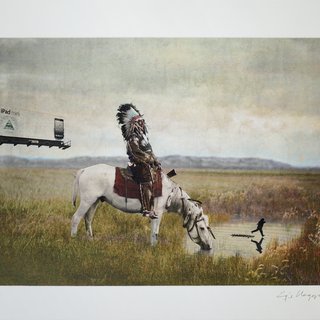About The Work
The muted palette and soft, matte surface of Enrique Chagoya’s 2016 editions Untitled (After Edward Curtis) and Untitled (After Yves Saint-Laurent) give the impression of visions unearthed from the depths of the subconscious, or hand-tinted antique photographs from a mysterious bygone era. In fact, both compositions originated as panels in Enrique Chagoya’s 2015 daguerreotype-as-codex edition Caníbales Daguerrotípicos, where Chagoya collided the pre-Columbian folding book format with the glossy, silver-grained look of 19th-century daguerreotypes to summon a surreal tableau of Modernist icons confronted in unexpected ways by the pre-Columbian and African cultures whose art and architecture they so often imitated and appropriated. Through the lens of Chagoya’s “reverse Modernism,” the historical relationship between Western art traditions and the “noble savage” is inverted and its unique absurdities are exposed; Picasso’s paintings mimicking African masks are the most well-known example of this problematic and one-sided cultural exchange, which Chagoya also links to photographers who made a career of depicting indigeneous peoples, like Eduard S. Curtis’s iconic images of the American West or Irving Penn’s depictions of Aborigines in Papua New Guinea.
In Untitled (After Edward Curtis), Chagoya places a billboard featuring an Apple iPad Mini and the “all-seeing eye” seen on the one-dollar bill into the pristine Western landscape of Curtis’s 1905 photograph An Oasis in the Badlands, adding a tiny leaping figure borrowed from Henri Cartier-Bresson’s iconic photograph Behind the Gare St. Lazare (1932). As Genevieve Quick explains, this figure embodies what Cartier-Bresson called the decisive moment – “the creative point when a photographer acts upon the world to freeze a moment, rendering it magical.” Meanwhile, Curtis’s landscape suggest his endeavors to create ‘authentic’ images of American West, which famously involved no small degree of stagecraft and spectacle. By colliding the ubiquitous advertising of today’s urban landscape with the dual visions of Curtis and Cartier-Bresson – “one where the photographer is in search of a specific picture and [one] that waits for the world to unfold” – Chagoya seems to ask how we can possibly “intervene in a world where corporate interests threaten the stability of place for those less powerful… [and] when is the ‘decisive moment’?”
Courtesy of Magnolia Editions
About Enrique Chagoya
Etching with acrylic
22.00 x 29.75 in
55.9 x 75.6 cm
Signed by the artist.
About The Work
The muted palette and soft, matte surface of Enrique Chagoya’s 2016 editions Untitled (After Edward Curtis) and Untitled (After Yves Saint-Laurent) give the impression of visions unearthed from the depths of the subconscious, or hand-tinted antique photographs from a mysterious bygone era. In fact, both compositions originated as panels in Enrique Chagoya’s 2015 daguerreotype-as-codex edition Caníbales Daguerrotípicos, where Chagoya collided the pre-Columbian folding book format with the glossy, silver-grained look of 19th-century daguerreotypes to summon a surreal tableau of Modernist icons confronted in unexpected ways by the pre-Columbian and African cultures whose art and architecture they so often imitated and appropriated. Through the lens of Chagoya’s “reverse Modernism,” the historical relationship between Western art traditions and the “noble savage” is inverted and its unique absurdities are exposed; Picasso’s paintings mimicking African masks are the most well-known example of this problematic and one-sided cultural exchange, which Chagoya also links to photographers who made a career of depicting indigeneous peoples, like Eduard S. Curtis’s iconic images of the American West or Irving Penn’s depictions of Aborigines in Papua New Guinea.
In Untitled (After Edward Curtis), Chagoya places a billboard featuring an Apple iPad Mini and the “all-seeing eye” seen on the one-dollar bill into the pristine Western landscape of Curtis’s 1905 photograph An Oasis in the Badlands, adding a tiny leaping figure borrowed from Henri Cartier-Bresson’s iconic photograph Behind the Gare St. Lazare (1932). As Genevieve Quick explains, this figure embodies what Cartier-Bresson called the decisive moment – “the creative point when a photographer acts upon the world to freeze a moment, rendering it magical.” Meanwhile, Curtis’s landscape suggest his endeavors to create ‘authentic’ images of American West, which famously involved no small degree of stagecraft and spectacle. By colliding the ubiquitous advertising of today’s urban landscape with the dual visions of Curtis and Cartier-Bresson – “one where the photographer is in search of a specific picture and [one] that waits for the world to unfold” – Chagoya seems to ask how we can possibly “intervene in a world where corporate interests threaten the stability of place for those less powerful… [and] when is the ‘decisive moment’?”
Courtesy of Magnolia Editions
About Enrique Chagoya
Published by Magnolia Editions.
- Ships in 10 to 14 business days from California. Framed works ship in 14 to 18 business days from New York.
- This work is final sale and not eligible for return.
- Questions about this work?
- Interested in other works by this artist or other artists? We will source them for you.
- Want to pay in installments?
Contact an Artspace Advisor
advisor@artspace.com



























